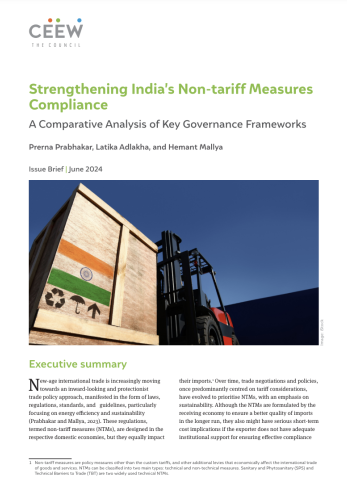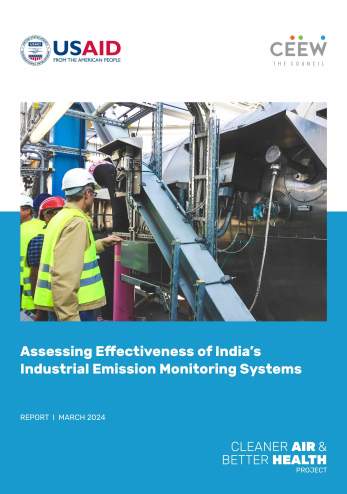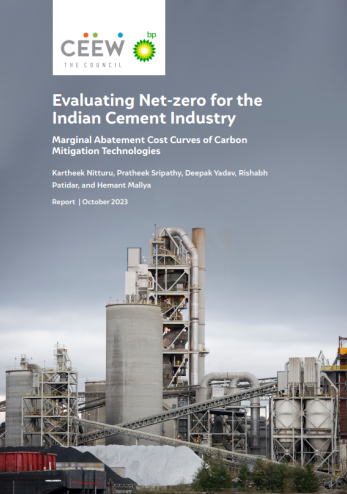



Suggested Citation: CFLI India and CEEW. 2024. Financing Green Hydrogen in India: Private Sector Considerations to Strengthen India’s Enabling Environment for a Competitive Green Hydrogen Economy. New Delhi: Council on Energy, Environment and Water (CEEW)
This report presents actionable private sector considerations for Indian policymakers at both the national and state levels to strengthen the enabling environment for green hydrogen uptake in India while also catalysing investment into the industry. These considerations align with the MNRE's mission components - generating demand, incentivising supply, and developing key enablers - and are supported by estimated demand projections as well as a breakeven cost analysis. The presented considerations, although tailored to the Indian context, may, in time, serve as an implementation blueprint for other international markets to promote green hydrogen. They are not intended to be a prescriptive set of policies, but rather, facilitate deeper public-private engagement on this topic.
The policy considerations presented in this report represent a suite of high potential, near-term actions that the Indian government could pursue to accelerate private investment in domestic green hydrogen production. However, not all barriers to investment can be solved through government-led interventions. Private-sector financial institutions, developers, and offtakers must partner with multilateral development banks, donors, and other development finance institutions to deploy innovative financing solutions at scale.
Financing green hydrogen and green ammonia projects remains a challenge, highlighted by the few projects that have secured sufficient financing to commence development. However, as demand increases, financiers must develop innovative financing solutions in response to market dynamics. In the meantime, existing projects that have received financing, as well as projects for proximate energy sources, such as renewables and liquefied natural gas, present valuable lessons.
Financial institutions could work with project developers to create standardised medium-term offtake agreements for green hydrogen, similar to the movement towards more standardised, bankable power purchase agreements in the renewable energy sector. A governmental nodal agency to facilitate such agreements would be critical. Financial institutions have indicated that 10-year offtake agreements would be sufficient, less than the typical project lifetime of 20–30 years. Since ammonia is a globally traded commodity with fluctuating prices, medium-term agreements can support developers and buyers, who need flexibility on pricing and volume.
Financial institutions could work with project developers and governments to design projects where renewable power generation capacity can be connected to the grid, providing an alternative revenue stream in case offtake risks make planned projects unviable. Although term-ahead and day-ahead markets in India have low trading volumes, they offer an avenue for project developers to sell excess power expeditiously. Purchase agreements should shield project developers from challenges in amortising capex in case of offtake risks. Finance professionals consider technology risks to be minimal, as most project costs will be related to proven technologies (e.g., solar, wind, and hydro-renewable power).
Learning 3: Manage currency risk with proven hedging products
Financial institutions could work with multilateral development banks and other organisations to develop currency hedging products for green hydrogen projects focused on export markets. For hydrogen and ammonia projects focusing on export markets, structuring contracts in USD rather than INR can mitigate currency risks associated with investments in India.
Financial institutions and developers could work with multilateral development banks and donors to facilitate the investment of concessional capital in the green hydrogen sector in India. Guarantees and viability gap funding mechanisms should be encouraged to lower the cost of capital for projects and make Indian green hydrogen and ammonia production competitive in global markets.
Green hydrogen/green ammonia production and its supporting distribution and storage infrastructure require high upfront capital investment and considerable effort in designing, structuring, and financing projects. Significant project preparation funding will be needed to bring more projects into the pipeline and move them towards fundraising. However, project developers have also found that mainstream financial institutions currently do not have the capacity to evaluate hydrogen and ammonia projects, given their lack of experience and familiarity with the idiosyncrasies of these projects. Resources are therefore required to draw together investors from across commodities, infrastructure, and liquefied natural gas teams, all of which can play a role in transferring knowledge from their verticals to the green hydrogen sector and help in better evaluating green hydrogen and ammonia projects.
Green hydrogen is the hydrogen produced through the use of renewable energy for the electrolysis of water.
Hydrogen can act as a fuel, industrial feedstock, reductant, and energy carrier. At present, most hydrogen used worldwide is grey – produced through natural gas reforming – a process that leads to significant greenhouse gas emissions. As countries seek to decarbonise their economy and reduce their dependence on fossil fuels, green hydrogen – produced using renewable energy to electrolyse water – will be critical for them to achieve their energy transition goals.
The geographical location of Indian industries will likely determine which regions drive domestic green hydrogen demand. Currently, Gujarat accounts for 30 per cent of India’s industrial hydrogen consumption, followed by Uttar Pradesh (17 per cent), Maharashtra (8 per cent), Rajasthan (7 per cent), and Madhya Pradesh (6 per cent). Going forward, the steel-producing states such as Jharkhand, Chhattisgarh, Odisha, and Karnataka may also emerge as large consumers of green hydrogen. The demand for green hydrogen for mobility applications will be dispersed throughout the country.
By leveraging its competitive advantage in renewable energy costs, India can emerge as a leading exporter of green hydrogen, especially in the short-to-medium term. Several European and East Asian countries have already stated their intentions to import green hydrogen and its derivatives, such as ammonia, to support their decarbonisation goals. Multiple Indian firms are proactively exploring export opportunities, having already announced several export-oriented projects for green ammonia production.

Strengthening India’s Non-tariff Measures’ Compliance

Evaluating Net-zero for the Indian Fertiliser Industry

Evaluating Net-zero for the Indian Aluminium Industry

Assessing Effectiveness of India’s Industrial Emission Monitoring Systems

Evaluating Net-zero for the Indian Cement Industry